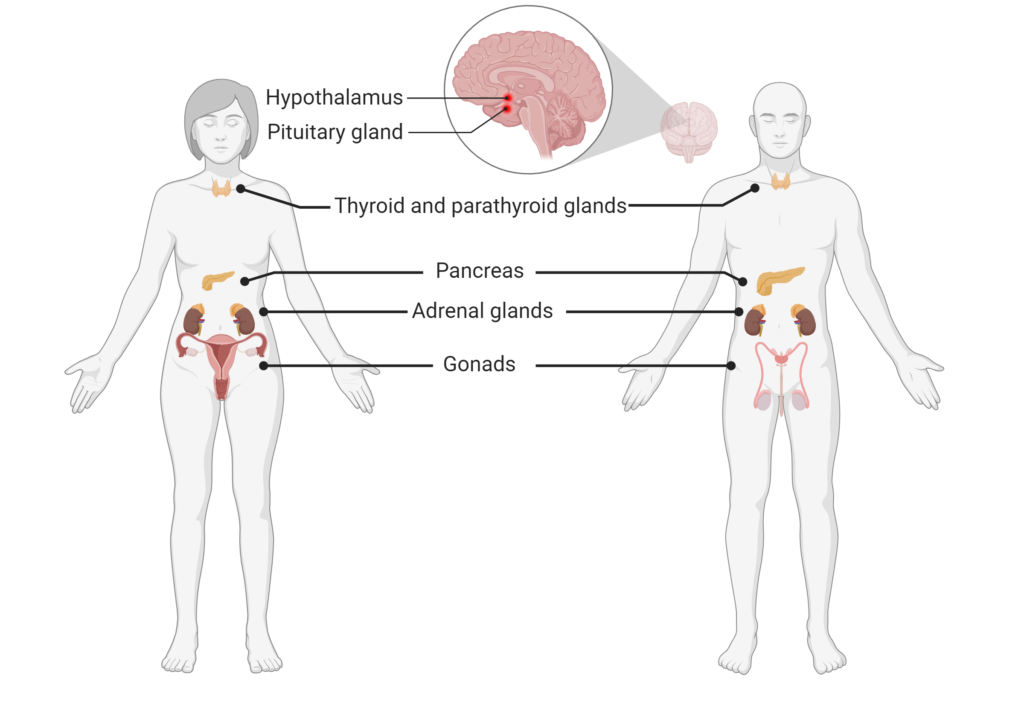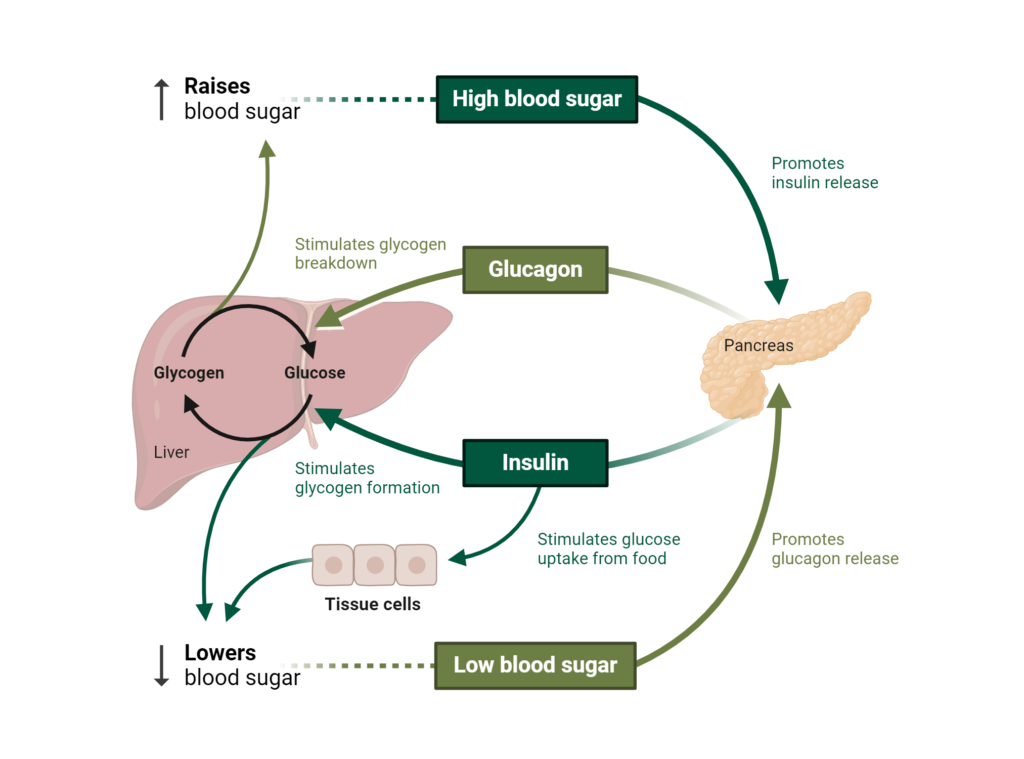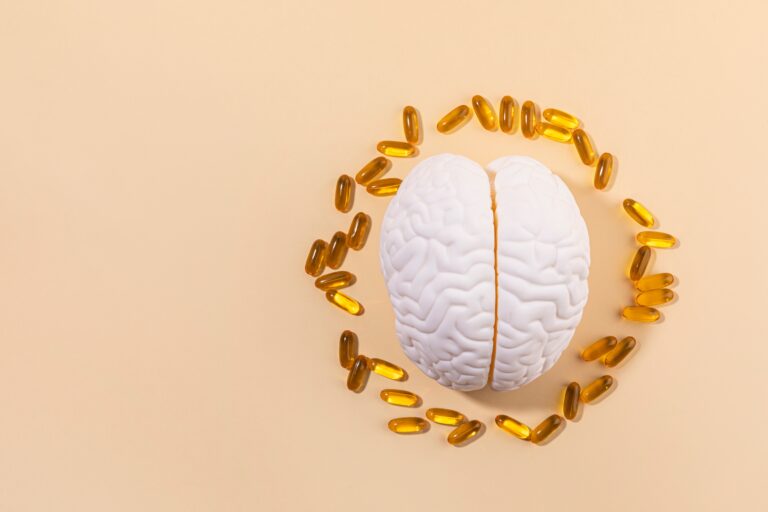Exploring the Interplay Between the Endocrine System and Nutrition for Optimal Health
The endocrine system is responsible for synthesizing and secreting hormones to maintain and regulate many bodily functions, including growth and development, metabolism, electrolyte balance, and reproduction.1 It is a complex, intricate system designed to regulate and maintain homeostasis of several different metabolic processes, but it can also be influenced by a variety of factors including nutrient intake, circadian rhythm, and exercise, underscoring the interplay between the endocrine system and nutrition.2,3 Important glands of the endocrine system include the hypothalamus, pituitary gland, adrenal glands, and thyroid gland.1
Overview of the Endocrine System
The endocrine system consists of glands and hormones throughout the body that allow for communication within and among the entire body to maintain homeostasis, or a constant internal environment.1 While the nervous system allows for information to travel within fractions of a second, the endocrine system produces hormones which are transported through the bloodstream for more widespread and longer-lasting communication and regulation.1
Good nutrition is critical to support the endocrine system. Macronutrients provide energy and structural components for hormone synthesis. Vitamins and minerals are necessary for many biochemical processes related to the synthesis and release of hormones within endocrine glands.1 Therefore, consuming a well-balanced, healthy diet can support overall endocrine system function.
The Function of the Endocrine System
Endocrine hormones influence every cell and organ in the body, interacting down to cellular receptors and nuclear DNA as well as impacting broader biochemical processes like metabolism.1 Together, endocrine organs and their hormones affect peripheral tissues to regulate growth, development, metabolism, electrolyte balance in fluids, and reproduction.1
Many hormones carry out their functions via signaling cascades, and all of the pieces of the cascade must be present for the signal to be efficiently and effectively transmitted. Adequate nutrient levels are required at each step of a given pathway in a signaling cascade. To achieve this, consistent nutrient intake is necessary.
Major Endocrine Glands in the Human Body
The endocrine system consists of several glands and tissues in the body that are responsible for synthesizing and secreting endocrine hormones which can then affect target organs or stimulate the release of other hormones.1

Image created using biorender.com
Hypothalamus
The hypothalamus produces regulatory hormones, including releasing and inhibiting hormones, that direct other endocrine tissues.1 For example, the hypothalamus is involved in the production of stress response hormones, including corticotropin-releasing hormone (CRH), which stimulates the pituitary gland to release adrenocorticotropic hormone (ACTH), which then triggers the release of cortisol from the adrenal glands.1 The hypothalamus also produces the inhibitor hormones somatostatin and dopamine which inhibit the release of growth hormone (GH) and prolactin, respectively.1
Pituitary
The pituitary gland releases hormones that act on other glands in the body as well as peripheral tissues.1 The anterior pituitary releases ACTH, thyroid stimulating hormone (TSH), GH, luteinizing hormone (LH), follicle-stimulating hormone (FSH), and prolactin while the posterior releases vasopressin and oxytocin.1
Adrenal glands
The adrenal glands are located on the kidneys and produce cortisol and aldosterone. Cortisol is critical for the stress response and aldosterone helps control water and electrolyte balance.1 The adrenal glands also produce other glucocorticoids and mineralocorticoids involved in the stress response.1
Gonads
The ovaries and testes synthesize sex hormones, including estrogen, testosterone, and progesterone. They are critical to the reproductive system and metabolic processes impacted by sex hormones.1
Thyroid and Parathyroid glands
The thyroid gland produces thyroid hormone which controls metabolic processes in cells. It also controls calcitonin which is involved in calcium homeostasis.1 The parathyroid gland, located near the thyroid gland, produces parathyroid hormone which also regulates calcium metabolism.1
Pancreas
The pancreas is important for digestion, but it is also an endocrine organ. It secretes the hormones insulin and glucagon, which regulate glucose metabolism.1
A balanced and coordinated endocrine system is critical to whole body health. Many of these glands overlap in the processes they regulate. Therefore, nutrient deficiency in one organ can have compounding effects throughout the rest of the endocrine system and body.
For example, in the thyroid gland, the minerals iodine, selenium, zinc, and iron are especially important and deficiencies in any of these can have significant effects on thyroid gland function.4 Iodine is required for the synthesis of thyroid hormones. Selenium is a critical component of the iodothyronine deiodinases which are selenoproteins that converts thyroxine (T4) into the bioactive triiodothyronine (T3).4,5 Insufficient levels of any of these minerals can impact metabolism throughout the body if thyroid hormone status is compromised.
Role of Hormones in the Body
Hormones allow the body to regulate a variety of processes, including growth and development, metabolism, reproduction, and mood.1 Hormones are produced and released into the bloodstream upon a specific stimulus where they are transported to various target organs.1
Some hormones affect many cell types while others are more specific and have only a few targets.1 Once the hormone binds to a receptor on the cell surface or inside a cell, a cascade reaction leads to changes in cellular function or activity, often by regulating expression of specific genes.1
Feedback Mechanisms in Hormone Regulation
Because the functions regulated by the endocrine system are so crucial to human life, there are multiple regulatory steps in place to ensure appropriate activation and signaling within the endocrine system.
For example, many functions in the body are regulated by several hormones that, in turn, regulate each other.1 The hypothalamus is particularly important in this regard as it secretes releasing hormones which then induce the synthesis and secretion of other hormones in tissues such as the pituitary gland. From there, the pituitary gland then releases hormones that affect the adrenal glands, gonads, and thyroid.1 Healthy eating, stress management, and engaging in regular exercise can positively influence the complex regulation involved in endocrine health.
The complicated feedback mechanisms that are critical to hormone regulation can be seen through the relationship between appetite and satiety hormones. While appetite hormones induce hunger and food-seeking behaviors, satiety hormones signal fullness to inhibit food intake.6
Before a meal, the stomach and gastrointestinal tract detect the absence of food, generating hormones that target the hypothalamus to produce and release hunger hormones such as Neuropeptide Y (NPY).6 However, after a meal, the stomach detects the presence of food and increasing levels of absorbed nutrients bind receptors to trigger the release of satiety signals that override hunger cues to inhibit food intake.
Many hunger and satiety hormones also regulate other hormones to ensure the appropriate response.6 Other hormones that contribute to appetite regulation include ghrelin, Cholecystokinin (CCK), and leptin which are produced in the stomach, small intestines, and white adipose tissue, respectively.
Nutritional Effects on Hormone Production
Proper nutrition is essential for hormone production. Macronutrients provide energy and structural compounds for hormone production while vitamins and minerals serve as cofactors or coenzymes for biochemical reactions that are directly and indirectly related to hormone synthesis. Healthy dietary intake can also support overall health by promoting antioxidant status and dampening inflammation.7
What is a Healthy Endocrine Diet?
A healthy endocrine diet should provide essential nutrients in required amounts, support the gut microbiome, contribute to redox balance, promote healthy inflammation, and help balance the immune system as all these components affect the endocrine system.4
Replacing highly processed foods with nutrient-dense foods is a great first step for supporting endocrine health. Nutrient-dense foods provide essential nutrients and often contain phytonutrients that further support antioxidant balance and healthy inflammation. Cutting processed foods can also naturally lower the intake of refined sugars, unhealthy fats, and compounds that do not support endocrine health.
A healthy diet, full of nutrient-dense foods, including soluble and insoluble fiber and phytonutrients, contributes to a healthy gut microbiome. The residents of the gut microbiome, in turn, support the endocrine system, interacting with hormones such as estrogens, androgens, and insulin.8 There is also complex crosstalk between the microbiota in the gut and endocrine tissues, including reproductive organs, adipose tissue, brain, and muscle via bile acids and short-chain fatty acids.8

The Impact of Unhealthy Dietary Choices
When dysbiosis in the gut microbiome occurs, potentially due to unhealthy dietary choices, it can lead to endocrine diseases including polycystic ovary syndrome and thyroid disorders.8 Other endocrine issues such as metabolic syndrome and obesity can drive further dysbiosis in the gut, creating a vicious cycle of gut microbiome and endocrine disturbances.8
Maintaining healthy inflammation and redox status is important for overall endocrine health as inflammation and oxidative stress can impair endocrine tissues, altering hormone production and secretion. Hormones control metabolism in cells throughout the body, which typically requires oxygen. As a natural by-product, reactive oxygen species form which means any change in hormone status of a cell or tissue can impact oxidative balance.9 Additionally, if certain hormones remain elevated for too long, such as aldosterone, they can exert detrimental effects on the body, including increasing oxidative stress, inflammation, and fibrosis, changing redox status, and ultimately resulting in serious conditions such as high blood pressure and cardiovascular disease.9
Nutrients that oppose oxidative stress and promote balance, such as the antioxidants vitamins C and E, as well as anti-inflammatory herbs and nutrients can help keep the endocrine system balanced and working efficiently. Dietary antioxidants, such as curcumin, N-acetyl cysteine, and phytonutrients can also help counteract the oxidative stress induced by other hormones, including aldosterone, glucocorticoids, and catecholamines.9
Foods Affecting Hormone Levels
Phytoestrogens are a well-known class of compounds that possess estrogen-like activity, although their exact consequences in the body are still being elucidated. Phytoestrogens share a similar structure as estrogen and can bind to estrogen receptors in the body.10 Common food sources of phytoestrogens include legumes, fruits, vegetables, and cereals.10
Phytoestrogens may lower the risk of certain diseases by influencing the endocrine system and exerting antioxidant, antiproliferative, and antiangiogenic actions, but other studies have found that they can also act as endocrine disruptors under certain conditions.10 The effects of phytoestrogens may depend on sex, ethnicity, age, health status, hormone levels, and the whole food matrix in which they are consumed.10
The Role of Macronutrients
Macronutrients are critical to the body’s overall health by providing energy for cells and serving important roles in the body. For example, dietary proteins are digested into polypeptide chains which provide the background for peptide hormones. In contrast, lipids derived from dietary fats can be important signaling molecules among cells in the endocrine system.
Additionally, these processes require energy, which comes from dietary macronutrients. Consuming macronutrients at an appropriate ratio is also important. For example, many organs in the body, especially the brain, run on glucose. However, too much glucose can cause issues elsewhere in the body, including exhausting the ability of the pancreas to produce insulin which can eventually lead to insulin resistance. The ratio of carbohydrates to fat to protein also dictates the secretion of specific appetite hormones. As such, obtaining macronutrients in a suitable range is crucial for proper hormone production and metabolism.
Impact of Dietary Patterns
Healthy dietary patterns can help maintain a consistent intake of essential vitamins and minerals. While there are major players for certain endocrine tissues – such as iodine in the thyroid– other micronutrients also impact these organs.
In the hypothalamus and pituitary gland for example, some genes are sensitive to the vitamin A receptors, resulting in changes in genetic expression when vitamin A is deficient.11 Similarly, selenium can also help maintain oxidative balance as a component of the selenoprotein glutathione peroxidase which functions as an antioxidant.5 Additionally, vitamin D may be an important endocrine-supporting nutrient as vitamin D receptors are found in several endocrine tissues including the anterior pituitary and thyroid gland.4
A healthy dietary pattern should provide sufficient calories through macronutrients and essential vitamins and minerals for health and wellness.
In addition to the specific effects of a certain dietary pattern, the timing of meals may also play a role in promoting a healthy endocrine system. Endocrine hormones follow a circadian rhythm, with levels fluctuating over 24 hours, but the responsiveness of target tissues to hormonal stimuli can also change.2 Because of this, following a consistent eating schedule can help align the body’s circadian rhythm which in turn can support endocrine function. Consuming appropriate portion sizes also helps keep hunger and satiety cues in a normal range, preventing large spikes and dips in response to a large meal.
Mediterranean Diet
The Mediterranean diet (MedDiet) is a popular, well-studied dietary pattern with many studies indicating that it has positive effects on several health measures, including endocrine health.12 It is characterized by a high intake of foods from vegetable sources, low consumption of saturated fats in favor of unsaturated fats, moderate intake of fish and dairy products, and lower intake of meat.4
The MedDiet overall also provides phytochemicals, including polyphenols and flavonoids, that exert positive effects on the body including antioxidant, anti-inflammatory, immuno-modulatory, and anti-diabetic actions.12 The fiber in the MedDiet also helps promote a healthy gut microbiome.12 Together, the components of the MedDiet and their health-promoting effects positively influence endocrine health and overall health.
Ketogenic Diet
Another dietary pattern that has received attention for its ability to benefit the endocrine system is the ketogenic diet. It is characterized by a high intake of fat, a moderate intake of protein, and a low intake of carbohydrates. The low carbohydrate intake helps stabilize blood glucose levels and reduce the load on the pancreas to produce enough insulin to combat high carbohydrate levels seen in the Standard American Diet.13 It also helps improve levels of several reproductive hormones including the ratio of LH to FSH and free testosterone percentage.13
The presence of ketones that is achieved on a ketogenic diet may also impact the synthesis and actions of the hormone’s insulin, glucagon, cortisol, multiple catecholamines, and growth hormone.13 Ketone bodies can also directly suppress appetite hormones, leading to higher satiety in addition to the satiating effects of a relatively high protein diet, ultimately influencing the levels of ghrelin and leptin.13

Adapted from “Regulation of Blood Glucose”, by BioRender.com (2004). Retrieved from https://app.biorender.com/biorender-templates
Endocrine Disruptors and Nutrition
Foods can provide support for the endocrine system, but they also may house endocrine disruptors. Endocrine-disrupting chemicals (EDCs) disrupt any aspect of hormone action and exposure to them has been associated with an increased risk of endocrine-related disorders.14 For example, exposure to bisphenol A (BPA) and phthalates have been both associated with an increased risk of diabetes and obesity.14 Endocrine-disrupting chemicals can affect one or multiple organs and often bind to various receptors such as estrogen-related receptors and receptors involved in inflammation.14
Certain EDCs can also be metabolized by gut microbiota, resulting in varying degrees of absorption, distribution, and metabolism depending on each person’s gut microbiome composition.14 EDCs further contribute to impaired endocrine function by disrupting circadian rhythm, impairing mitochondrial function in metabolic tissues, and increasing endoplasmic reticulum stress, both of which can lead to increased oxidative stress, inflammation, and metabolic dysfunction.14
Alcohol is considered to be an endocrine disruptor because it can alter the release of hormones in the hypothalamic-pituitary-thyroid (HPT) axis, although its specific effects differ in alcoholics compared to non-alcoholics.1 Both acute and chronic intake can cause disturbances, but after chronic consumption, alcohol can cause hormone dysregulation resulting in stress issues, reproductive problems, immune dysfunction, thyroid problems, and bone issues.15
How to Limit the Effects of Endocrine-Disrupting Chemicals
To limit the detrimental effects of EDCs, it is imperative for patients to avoid as many EDCs as possible. Patients can reduce exposure and counteract the effects of EDCs that make it into the body by:
- Choosing organic produce
- Avoiding binge-drinking of alcohol
- Choosing nutrient-dense foods over processed foods can reduce exposure
- Consuming nutrients that support healthy inflammation and function as antioxidants
- Undergoing metabolic detoxification programs with whole food nutrition support to help the body efficiently detoxify and eliminate harmful endocrine-disrupting compounds
Additionally, it is important to note that highly processed foods are often packaged in potentially harmful plastics which act as EDCs and some processed foods even contain EDCs, such as nitrites.4
Creating a supportive nutritional environment via a balanced diet and mindful lifestyle choices is essential for optimizing endocrine function and improving overall well-being. Understanding the intricate connection between nutrition and the endocrine system enables practitioners to proactively assist their patients in achieving and maintaining optimal health. This involves customizing dietary advice and lifestyle adjustments to target and eliminate specific endocrine issues, fostering long-term health benefits. Empowering patients with knowledge about how nutrition affects their endocrine system enables them to make informed decisions that not only improve their health but also their quality of life.
Did you know Wholistic Matters is powered by Standard Process? Learn more about healthcare practitioner benefits.
- Hiller-Sturmhöfel, S., Bartke, A. (1998). The Endocrine System: An Overview. Alcohol Health Res World, 22(3):153.
- Gamble, K.L., Berry, R., Frank, S.J., Young, M.E. (2014). Circadian Clock Control of Endocrine Factors. Nat Rev Endocrinol, 10(8):466.
- Athanasiou, N., Bogdanis, G.C., Mastorakos, G. (2023). Endocrine responses of the stress system to different types of exercise. Rev Endocr Metab Disord, 24(2):251.
- Ruggeri, R.M., Barbalace, M.C., Croce, L., Malaguti, M., Campenni, A., Rotondi, M., Cannavo, S., Hrelia, S. (2023). Autoimmune Thyroid Disorders: The Mediterranean Diet as a Protective Choice. Nutrients, 15:3953.
- Beckett, G.J., Arthur, J.R. (2005). Selenium and endocrine systems. J Endocrinol, 184:455.
- Alhabeeb, H., AlFaiz, A., Kutbi, E., AlShahrani, D., Alsuhail, A., AlRajhi, S., Alotaibi, N., Alotaibi, K., AlAmri, S., Alghamdi, S., AlJohani, N. (2021). Gut Hormones in Health and Obesity: The Upcoming Role of Short Chain Fatty Acids. Nutrients, 13:481.
- Biswas, S.K. (2016). Does the Interdependence between Oxidative Stress and Inflammation Explain the Antioxidant Paradox? Oxid Med Cell Longev, 2016:5698931.
- Qi, X., Yun, C., Pang, Y., Qiao, J. (2021). The impact of the gut microbiota on the reproductive and metabolic endocrine system. Gut Microbes, 13(1):e1894070.
- Sahoo, D.K., Chainy, G.B.N. (2023). Hormone-linked redox status and its modulation by antioxidants. Vitamins and Hormones, 121:197.
- Dominguez-Lopez, I., Yago-Aragon, M., Salas-Huetos, A., Tresserra-Rimbau, A., Hurtado-Barroso, S. (2020). Effects of Dietary Phytoestrogens on Hormones throughout a Human Lifespan: A Review. Nutrients, 12:2456.
- Brossaud, J., Pallett, V. Corcuff, J.-B. (2017). Vitamin A, endocrine tissues and hormones: interplay and interactions. Endocr Connect, 6(7):R121.
- Barrea, L., Verde, L., Annunziata, G., Camajani, E., Caprio, M., Sojat, A.S., Marina, L.V., Guarnotta, V., Colao, A., Muscogiuri, G. (2024). Role of Mediterranean diet in endocrine diseases: a joint overview by the endocrinologist and the nutritionist. J Endocrinol Invest, 47:17.
- Gupta, L., Khandelwal, D., Kalra, S., Gupta, P., Dutta, D., Aggarwal, S. (2017). Ketogenic diet in endocrine disorders: Current perspectives. J Postgrad Med, 63(4):242.
- Bansal, A., Henao-Mejia, J., Simmons, R.A. (2018). Immune System: An Emerging Player in Mediating Effects of Endocrine Disruptors on Metabolic Health. Endocrinology, 159(1):32.
- Rachdaoui, N., Sarkar, D.K. (2013). Effects of Alcohol on the Endocrine System. Endocrinol Metab Clin North Am, 42(3):593.







